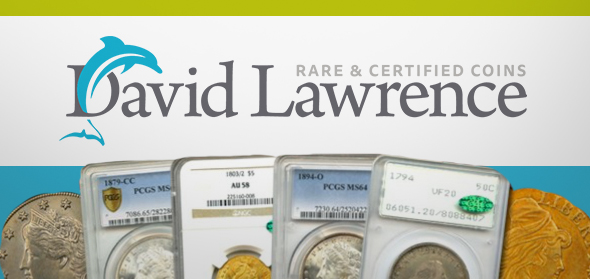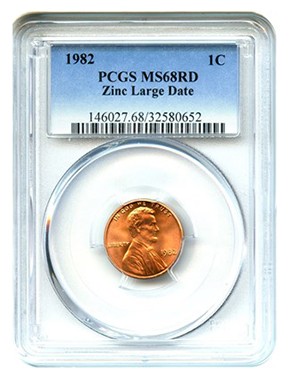
The numismatic firm David Lawrence Rare Coins, located in Virginia Beach, Virginia, has been offering online coin auctions for several years. Each David Lawrence auction offers a nice array of circulated, uncirculated, and proof classic and modern coins, as well as many foreign coins. The vast selection of copper, nickel, silver, and gold coins includes suitable pieces for coin collectors on virtually any budget, ensuring there is something for just about every numismatist who peruses the auction listings.
David Lawrence Rare Coins doesn’t charge buyer’s premiums – something that many other online coin auctions add to the final bid of coins, often increasing the final price by 8 to 15 percent. That means buying coins from David Lawrence Rare Coin auctions may be more affordable than purchasing similar pieces from other online auctions.
Auction #866 Wrap Up
The typical David Lawrence rare coin auction features anywhere from 150 to 300 lots. Here’s a glimpse at just some of the lots that were sold in David Lawrence online auction #866.
#1 – 1806 Draped Bust Half Cent (Large 6, Stems) PCGS MS 62 Red-Brown CAC Designation, $3,290.00
Many numismatists are accustomed to finding early U.S. coins in well-worn condition. Of course, that’s because most U.S. issues from the late 18th and early 19th century were made in relatively small numbers, even given the fledgling population of the United States at the time, and therefore saw heavy use. Thankfully for coin collectors, a tiny fraction of these early coins were saved, and this 1806 Draped Bust half cent was among the few early 19th-century coins that survived as an uncirculated specimen. This coin, which received a grade of Mint State-62 by the Professional Coin Grading Service (PCGS), managed to receive approval from the Certified Acceptance Corporation (CAC), which awards a labels to coins the organization deems to have especially nice eye appeal. PCGS reports 14 specimens have received a grade of MS-62 RB, with 29 grading higher up to MS-64.
#2 – 1880 Seated Liberty Quarter PCGS MS-66 CAC Designation, $2,700.00
Seated Liberty quarters were made in tiny quantities throughout much of the 1880s, which means this 1880 quarter is a tough find in any grade. At MS-66, this specimen is decidedly scarce, with its CAC designation acknowledging the coin’s attractive surfaces. 13,600 Seated Liberty quarters were minted in 1880, though far fewer survive, and only a handful remain in Mint State grades. PCGS reports 35 grading MS-66 with 18 grading higher.
#3 – 1951-S Franklin Half Dollar PCGS MS-65 Full Bell Lines CAC Designation $340.00
When buying a high-grade specimen of their favorite coin, Franklin half dollar enthusiasts usually focus much of their attention on one design element – the Liberty Bell on the reverse. If the Liberty Bell’s horizontal lines, which usually failed to fully strike up, are crisp and clearly defined, the coin is a winner. That’s the case with this frosty, white 1951 Franklin half dollar, which earned a respectable MS-65 grade from PCGS and approval from the CAC.
#4 – 1895-S Morgan Dollar PCGS MS-64 CAC Designation, $10,250.00
Among the perennially popular Morgan silver dollars are several dates that are scarce by virtually any measure, and dollars from 1895 are definitely among the scarcest issues of the long-running series. In fact, barely more than 850,000 were struck at the Philadelphia, New Orleans, and San Francisco mints combined, and far fewer survive today. Of the three Morgan dollar issues of 1895, that year’s San Francisco coin is generally the least expensive across the grading spectrum. Still, this MS-64 specimen managed to sell for more than $10,000, which is not surprising given the fact that only 400,000 pieces were made at the San Francisco mint. From that original issuance, PCGS has awarded the grade of MS-64 to 420 pieces (not considering proof-like or deep-mirror specimens), which, given the large number of Morgan dollar collectors, suggests there is a relatively tiny number of gem specimens to go around.
#5 – 2014-S Baseball Hall of Fame Half Dollar PCGS Proof-69 Deep Cameo (First Strike), $55.00
While many numismatists tend to focus on classic issues such as Draped Bust half cents, Seated Liberty quarters, or Morgan silver dollars, there are some modern coins that are deservedly earning significant coin collector attention. The 2014 Baseball Hall of Fame commemorative coins became the first curved U.S. coins, and the half dollar became the first domed copper-nickel clad coin. The curved surfaces provide unique depth for the design, which features a baseball glove on the concave obverse and Major League-style baseball on the convex reverse.
Auction #867 Preview
Perhaps you didn’t have the opportunity to bid on any of the coins in the previous David Lawrence Rare Coins auction and are curious about what coins will be crossing the online auction block next. Here is a rundown of five coins that are being offered in David Lawrence Auction #867, which will close on Sunday, August 2, 2015.
#1 – 1857 Flying Eagle Cent PCGS MS-65
Not counting the 1856 Flying Eagle cent, which is technically regarded as a pattern coin, the 1857 became the first official U.S. small cent. Many are found in the grade range of Good to Extremely Fine, with few surviving in better condition. This piece, however, was graded MS-65 by PCGS. According to population reports, PCGS and NGC together have graded only 455 of the original 17,450,000 business strikes as MS-65, with just 33 grading MS-66 – the highest-known grade for this issue.
#2 – 1982 Zinc Large Date Lincoln Cent PCGS MS-68 Red
 Many coin collectors don’t often think of modern Lincoln cents as being difficult to find in the upper Mint State grades, so perhaps many of these numismatists would be surprised to learn that some recent pennies, particularly zinc-based Lincolns, are generally tough to find in grades above MS-65. 1982 cents [https://coinweek.com/education/coin-analyst-1982-lincoln-cent-provides-collectors-challenges-rewards/] certainly provide coin collectors with a unique set of challenges, as the year saw production of seven different types of business-strike pennies of the former copper-based and newer zinc compositions. Additionally, no official uncirculated sets were made in 1982 (or 1983), making it much more difficult for numismatists to find high-quality specimens of these coins. The 1982-dated MS-68 Lincoln cent offered in the current David Lawrence auction is tied for the highest-grading specimen of this issue, making it a prime registry set candidate.
Many coin collectors don’t often think of modern Lincoln cents as being difficult to find in the upper Mint State grades, so perhaps many of these numismatists would be surprised to learn that some recent pennies, particularly zinc-based Lincolns, are generally tough to find in grades above MS-65. 1982 cents [https://coinweek.com/education/coin-analyst-1982-lincoln-cent-provides-collectors-challenges-rewards/] certainly provide coin collectors with a unique set of challenges, as the year saw production of seven different types of business-strike pennies of the former copper-based and newer zinc compositions. Additionally, no official uncirculated sets were made in 1982 (or 1983), making it much more difficult for numismatists to find high-quality specimens of these coins. The 1982-dated MS-68 Lincoln cent offered in the current David Lawrence auction is tied for the highest-grading specimen of this issue, making it a prime registry set candidate.
#3 – 1916-D Mercury Dime PCGS Good-4 CAC Designation
Lightly circulated and Mint State key-date coins are great, but just about everyone loves a solid, well-circulated 1916-D Mercury dime with honest wear. Though the coin’s surfaces show little more than the basic details, perhaps the two most important features – the “1916” date and the “D” mintmark representing Denver – are fully intact. The CAC apparently approved of the coin’s deep, silvery-gray original color, overall even wear, and pleasing appearance.
#4 – 1794 Flowing Hair Half Dollar PCGS VF-20 CAC Designation
This sonically sealed beauty is inside an original PCGS holder from the 1980s, a time when the certification firm earned an early reputation for its conservative grading practices. This gorgeous 1794 half dollar, among the first of its denomination, appears to qualify in every respect for the Very Fine-20 grade emblazoned across its grading label. Boasting sharp detail in all the primary areas of the coin, not to mention its handsome brown and silvery-gray surface coloration, one would be hard pressed to find a better-looking specimen for the grade. The CAC has approved just five 1794 half dollars in this grade, including this specimen. It’s important to remember that early U.S. coins such as this piece were made in very small numbers and saw heavy circulation. 23,464 half dollars were minted in 1794, and roughly 800 of these coins across all grades have been certified between PCGS and the Numismatic Guaranty Corporation (NGC); it’s safe to suggest the figure of approximately 800 certified specimens probably represents a very large percentage of the overall surviving population.
#5 – Switzerland 1916 B 20 Gold Franc NGC MS-65
One of the most popular classic world gold coins is Switzerland’s 20 Franc Helvetia (or Vreneli), which was originally minted from 1897 through 1936. The obverse of the coin features a left-facing portrait of Verena (Switzerland’s Lady Liberty or, as some informally call her, “Swiss Miss”); on the reverse is the Swiss shield. This issue, minted in Bern, has a fineness of 0.900, contains 5.805 grams of gold and measures 21 millimeters across, which is roughly the same diameter as a U.S. five-cent coin.
Even if you don’t plan on buying any of the coins listed above, surely the diversity of the pieces offered in both the previous and current David Lawrence rare coin auctions could inspire you to explore the breadth of the coins that await you. The proverbial bourse is full of fascinating coins with interesting stories, so why not check out some new treasures that tickle your numismatic fancy?
Happy collecting!




